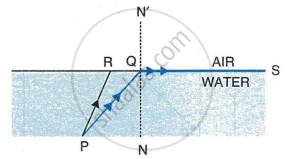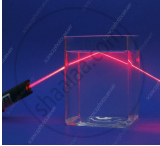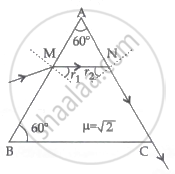Advertisements
Advertisements
प्रश्न
The diagram below shows a point source P inside a water container. Four rays A, B, C, D starting from the source P are shown up to the water surface

1) Show in the diagram the path of these rays after striking the water surface.
The Critical Angle for the water-air surface is 48°.
2) Name the phenomenon which the rays B and D exhibit.
उत्तर
1) Path of the rays after striking the water surface is shown below:

2) Ray 'B' and ray 'D' exhibit the phenomenon of reflection and total internal reflection (TIR), respectively.
APPEARS IN
संबंधित प्रश्न
A ray of light travels from water to air as shown in the diagram given below :

1) Copy the diagram and complete the path of the way. Given the critical angle for water is 48°.
2) State the condition so that internal reflection occurs in the above diagram.
Draw the diagram of a right-angled isosceles prism which is used to make an invented image erect
In the given figure PQ and PR are the two light rays emerging from an object P. The ray PQ is refracted as QS.

- State the special name given to the angle of incidence ∠PQN of the ray PQ.
- What is the angle of refraction for the refracted ray QS?
- Name the phenomenon that occurs if the angle of incidence ∠PQN is increased.
- The ray PR suffers partial reflection and refraction on the water-air surface. Give reason.
- Draw in the diagram the refracted ray for the incident ray PR and hence show the position of image of the object P by the letter P’ when seen vertically from above.
Write the relation between the refractive index and critical angle for a given pair of optical media?
If a ray of light passes from medium I to medium II without any change of direction, what can be said about the refractive indices of these media (angle I is not 0)?
Observe the given figure and write appropriate phenomenon of light in the box.

A green light is incident from the water to the air-water interface at the critical angle (θ). Select the correct statement.
A Rainbow is a beautiful natural phenomenon formed because of the following:
A ray of light passes through a prism of refractive index `sqrt2` as shown in the figure. Find:

- The angle of incidence (∠r2) at face AC.
- The angle of minimum deviation for this prism.
A ray of light passes from vacuum into a medium of refractive index µ, the angle of incidence is found to be twice the angle of refraction. Then the angle of incidence is ______.
